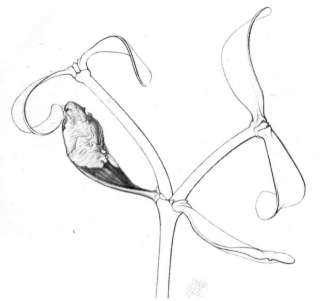
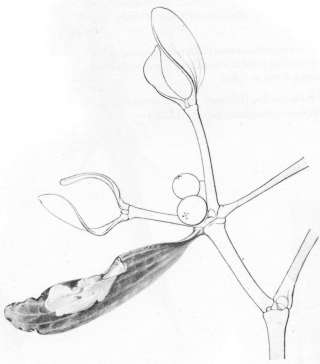
Worcestershire Record No. 19 November 2005 p. 18 - 19
Over the years we have included several articles (see references list) on the invertebrates associated with mistletoe Viscum album in Worcestershire Record. Despite the interest that has arisen from the discovery of the Mistletoe Weevil Ixapion variegatum, first in Herefordshire and then Worcestershire, records of the Mistletoe micro-moth Celypha Woodiana have not been forthcoming. In 2003 Tony Simpson asked naturalists to look-out for this species and his article is reprinted below, followed by further comments and illustrations. The larvae forms leaf mines in mistletoe. These are very small in early winter but it is worth searching for them in the undersides of mistletoe leaves. If you find any please contact
For Worcestershire: Tony Simpson on 01886 832637, and for Herefordshire Michael Harper on 01531 632030. If you are unable to make contact with them contact Harry Green zen130501@zen.co.uk 01386 710377, 07778 198476. If you find mines on leaves which have already been picked please store them in a lidded jar until you contact us. Photographs or digital pictures would be a useful aid to identification.
Tony Simpson (reprinted, with minor changes, from Worcestershire Record No. 14)
In 1878 Dr. J.H. Wood, who was a Herefordshire General Practitioner and amateur entomologist who lived at Tarrington, first identified a small tortricid moth, which was named in his honour by Barrett, who wrote its scientific description from his specimens. In 1892 Wood discovered its life history. He wrote in the Victoria County History of 1908 "orchards, the moth at rest on the trunks of the apple trees and the larva (more frequent) mining the leaves of mistletoe. There is no record of its having occurred outside the county, and it is apparently unknown abroad". Bradley, Tremewan and Smith (1979) give its known range as "Northern and central Europe to U.S.S.R." In Britain it has only ever been found in Herefordshire, Worcestershire, Gloucestershire, Monmouthshire, Somerset, and in just over the border in Warwickshire.
I found the larvae on mistletoe on pear and apple trees in an old orchard at Drakes Broughton in May 1980, and I bred seven moths. It was also found on mistletoe on a planted Rowan tree beside the Droitwich Road in Claines, Worcester in May 1980, adjacent to some old apple trees in an allotment. These trees have now gone. I have not found it anywhere else, but Michael Harper has found it very locally in a few old orchards in Herefordshire. Most of the old orchards in both counties have now been grubbed up and this is a very threatened habitat. Surveys of mistletoe suggest that the plant is doing well despite the loss of orchards because it is able to live on other trees and shrubs, especially Poplars, Limes, and Hawthorns. We do not know however if the moth can survive on mistletoe in these situations, and I feel we should try to survey mistletoe for the presence of woodiana in the two counties.
This is easier said than done however! The small green larva mines in the leaves of mistletoe from the autumn. At first the mines are very inconspicuous, but in April and early May it makes inflated blister-like mines in the leaves, which are initially pale but when vacated go dark brown. Later in June the mined leaves fall off, and so old mines are usually no longer visible after this time. Therefore the mines would only be likely to be found at the end of April and May. The other problem is that most of the mistletoe clumps are out of reach from the ground without the use of a ladder. Mistletoe on larger trees such as Poplars and Limes would be almost entirely out of reach to all practical purposes. One way, once one could confidently identify the mines, might be to use binoculars to find them on the higher trees, or at least use this method as a survey to identify potential mines from below. This method has not yet been shown to be useful and accurate however. Finding the moth resting on tree trunks would be a much less easy way of finding the species.
We would like to ask recorders to look for possible mined leaves in April and May, and if they are accessible (usually in orchard or garden fruit trees), pick a few and keep them, and give or send them to us for confirmation. Please do not take any risks by climbing trees, and avoid going up tall trees altogether! If you have or see any likely mistletoe mines please give us a ring.
The following account is extracted from Bradley JD., Tremewan WG, & Smith A 1979 British Torticoid Moths: Torticidae: Olethreutinae. The Ray Society London. (Vol 2).
TORTRICIDAE: OLETHREUTINAE
Celypha woodiana (Barrett), the second page on the species: page 17 in the book.
COMMENTS
A distinctive species, but in forewing markings it is similar to Apotomis lineana from which it may be distinguished by its smaller size, comparatively narrow forewings with a relatively straight costa, the white ground colour and more contrasting markings, the dark labial palpi, head and thorax, and the grey cilia of the hindwing.
BIOLOGY
Larva. Head shining black, mandibles brown; prothoracic plate black, with a whitish green medial sulcus; abdomen deep green; pinacula small, blackish green; anal plate black, or greenish brown mottled with black; thoracic legs dark grey or black. Autumn to April or May, over-wintering as an early instar; feeding on Viscum album, mining in the leaves throughout its development. Until about mid April the larva lives in a narrow crescent-shaped mine on the underside of the leaf; it then gradually hollows out the leaf and forms a large blister-like mine (pl. I, figs. I, 2), partly lined with silk (Wood, 1892: 225).
Pupa. Yellowish or reddish brown. June; in a loosely spun, white cocoon under bark or under lichen growing on the branches or trunk of the host tree.
Imago. July and August; frequenting old apple orchards where mistletoe occurs. The moth rests on the trunks of apple trees during the day, darting to the ground when disturbed. It is on the wing towards dusk, later coming to light.
DISTRIBUTION
This species is apparently restricted to old apple orchards in the west of England. It was first discovered at Tarrington, Herefordshire, in July, 1878 by J. H. Wood who collected a number of moths from the trunks of apple trees (Barrett, I878b: 241; I882: I85). It appears to be local and rare and almost restricted to Herefordshire, Worcestershire, Gloucestershire and Monmouthshire. Known localities include Breinton, Byford and Tarrington (Herefordshire), Droitwich (Worcestershire), Tetbury (Gloucestershire) (Newton, 1963: q.6), Tintern (Monmouthshire) and Bickenhall (Somerset). Central Europe to U.S.S.R.
 |
 |
| Late spring blister mine Celypha woodiana. Drawings from Bradley J D, Tremewan W G and Smith A 1979 | |
In a recent exchange of emails with Jon Cooter of Hereford he mentioned that survey work in Herefordshire orchards had failed to find Celypha woodiana despite searching for the characteristic mines in mistletoe leaves. I thought it would be useful to follow this up and look again for the species in Worcestershire and felt it would be helpful to know exactly what the mines looked like. Jon kindly reminded me of the illustrations in Bradley, Tremewan & Smith but he did not know of any recent photographs. The internet came to the rescue and led me to the web site www.leafmines.co.uk where there are pictures of Celypha woodiana mines. This in turn led me to the photographer Robert Homan who kindly sent me five images with permission to use them in Worcestershire Record. He wrote of the images:
All Celypha woodiana - Coombe Hill, Gloucestershire, VC 33, 2004/5. Found on mistletoe growing on large hawthorn bushes on the boundary of the Gloucestershire Wildlife Trust reserve. Coombe Hill is in SO 8827, approximately 6 km south of Tewkesbury, so it is not really that far from the modern day Gloucestershire/Worcestershire boundary and is only approximately 4 km SE of the area of VC 37 around Chaceley which is in the modern administrative Gloucestershire.
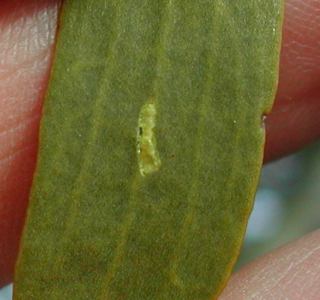 |
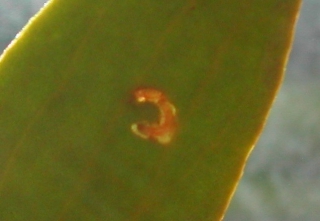 |
| Picture taken in field 30th December 2004 | Taken 8th January 2005 |
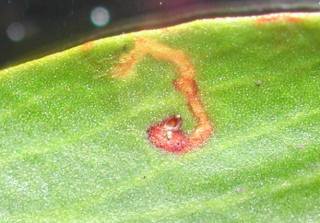 |
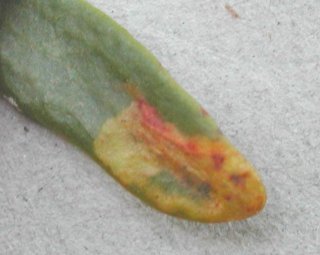 |
| Taken 11th January 2005, I suspect that this shows two mines |
Taken in field 8th May 2005 |
Acknowledgements:
Many thanks to the web site www.leafmines.co.uk.
and those who run it. Also to Robert Homan for supplying the pictures, and
Jonathan Cooter for helpful information.
References:
| BRADLEY JD., TREMEWAN WG, & SMITH A 1979. British Torticoid Moths: Torticidae: Olethreutinae. The Ray Society London. (Vol 2). | |
| GREEN H 7 MEIKLEJOHN JW 2004. Mistletoe bugs and a weevil Ixapion variegatum in Worcestershire. Worcestershire Record 17, pages 24-25 | |
| GREEN H & MEIKLJOHN J 2000. Mistletoe bugs. Worcestershire Record. 9 page 23. | |
| SIMPSON ANB 2003. Celypha woodiana: a rare and localised insect for
recorders to look out for. Worcestershire Record 14, page 17 |
| WBRC Home | Worcs Record Listing by Issue | Worcs Record Listing by Subject |